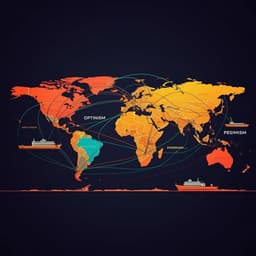
Economics
Strategies for selecting trading partners based on economic complexity of international trade networks: A comparison between Chinese and the US markets
Z. Ren, W. Du, et al.
This fascinating research, conducted by Zhuoming Ren, Wenli Du, Ziyi Zhao, Li Zhao, and Tongfeng Weng, delves into the complexities of trading partner selection through the lens of economic complexity theory. It reveals unique market dynamics and strategic insights into diversification and clustering within Chinese and US trade networks from 2001 to 2015.
~3 min • Beginner • English
Introduction
The study addresses how exporting countries can more effectively select trading partners under rising uncertainty in global trade, particularly amid escalating China–US tensions. Traditional partner-selection tools (e.g., gravity models, PESTEL) and single- or few-dimension indicators (comparative advantage, trade costs, policy, reputation) lack comprehensive, future-oriented guidance and can be cumbersome due to weighting decisions. Economic complexity provides a data-driven, systems-oriented framework to infer productive capabilities from export outcomes, outperforming classical indicators in predicting growth. The paper asks how economic complexity measures—product proximity and country/product complexity—can guide exporting countries in: (i) expanding towards more sophisticated products; (ii) diversifying export baskets; and (iii) assessing product dependence and trading positions across target markets (China, US) relative to the world benchmark. It posits that market-specific complexity results offer more precise criteria for partner selection and strategic product upgrading than global-only analyses.
Literature Review
The paper situates itself in three streams of economic complexity research: (1) global bipartite exporter–product networks using international trade data to map product space and upgrading paths; (2) subnational applications (e.g., Chinese provinces, Japanese prefectures) to guide internal development; and (3) single-country trade perspectives assessing partner and product rankings. Existing studies rarely use economic complexity directly for selecting trade partners or for cross-market comparisons, and single-country data can be inconsistent with global datasets, potentially biasing decisions. Traditional approaches (gravity models; multi-criteria tools like PESTEL) either focus on bilateral flows without macro, data-driven insights or lack comprehensive, outcome-based measures of productive knowledge. Economic complexity indices (ECI/PCI via Method of Reflections; Fitness-based measures) have been applied to development, green transitions, and inequality, but comparative market-oriented partner selection remains underexplored.
Methodology
Data: International trade data (SITC Rev.2) from the Harvard Growth Lab (cleaned COMTRADE), 2001–2015. Variables extracted: exporter, importer, product codes (4-digit SITC Rev.2), export values. Three sub-datasets constructed for the world, China, and US markets. Country sample filtered for stability following literature: availability of product trade and 2008 income data; population >1.2 million; average annual exports ≥USD 1 billion (2006–2008); exclusion of Iraq, Macau, and Chad due to data quality. Final target: 128 exporting countries (for 2001–2015). Due to missing records under specific perspectives, correlation analyses use 117 countries and 757 common products across all years. Analyses are conducted in three periods: 2001–2005, 2006–2010, 2011–2015.
Product proximity: Construct country–product export matrices for each perspective using Revealed Comparative Advantage (RCA>1). Proximity between products i and j at time t is Pij = min{P(RCAi|RCAj), P(RCAj|RCAi)}. Proximity matrices are averaged over adjacent five-year windows to stabilize estimates and visualized as heatmaps (757×757; 572,292 pairwise proximities). Bright regions indicate product clusters with higher likelihood of co-export and easier diversification/upgrading.
Economic complexity indices: Normalize export matrices by RCA to binary M (Mcp=1 if RCAcp>1, else 0). Country diversity Kc,0=ΣpMcp; product ubiquity Kp,0=ΣcMcp. Iterative Method of Reflections yields Kc,N and Kp,N; ECI is the standardized eigenvector associated with the second-largest eigenvalue of the country–country matrix; PCI analogously from the product–product matrix. ECI measures exporting countries’ trade positions; PCI measures product complexity/dependence within each market perspective.
Comparative analyses: (i) Proximity heatmaps across world/China/US and over time; (ii) Spearman correlations of ECI and PCI across perspectives with significance testing (p<0.001); (iii) Visual trend comparisons of ECI/PCI; (iv) Extreme-value analyses of gaps (CHN−WLD; USA−WLD) for countries and products to identify market-specific advantages/disadvantages relevant to partner selection.
Key Findings
- Product proximity and diversification paths:
- World proximity heatmap exhibits relatively even distribution; China and US show pronounced clustered “bright” partitions. Low-proximity clusters are concentrated in SITC 11–4312 (e.g., live animals, meat, dairy, fish, cereals), implying higher upgrading difficulty for exporters specializing only in these products in China/US markets.
- Over time (2001–2005, 2006–2010, 2011–2015), China’s product proximity increases, especially in textiles and manufactured goods (SITC 8421–8744), indicating rising probability of co-export and easier diversification. The US shows relatively stable or declining proximity, with weakened links among specific categories (e.g., 431*, 514*, 73**).
- Average proximity scores (means): World 0.1871, 0.1934, 0.1940; China 0.1493, 0.1545, 0.1551; US 0.1403, 0.1382, 0.1345 across the three periods, respectively. Zero-proximity counts (indicating no co-export evidence) grow most in the US (41,614; 43,786; 54,308), then China (33,766; 35,478; 42,964), least in the world (7,378; 6,830; 7,842).
- ECI/PCI correlations across perspectives (2006–2010, p<0.001):
- ECI: China–World ≈0.92 (high), US–World lower, China–US lowest ≈0.60, indicating distinct market structures between China and the US. Over time, China–World correlations increase then stabilize; US–China correlations decrease then stabilize.
- PCI: China–World relatively high (≈0.83) and stable; US–World declines; China–US around ≈0.65 across nodes. This suggests China’s market outcomes align more closely with world averages than the US.
- Market-specific dependence and positioning:
- China exhibits lower PCI for resource/raw categories (SITC 2–4), consistent with low import dependence on coal/coke (SITC 3). Machinery and transport equipment (SITC 7) show higher world PCI than in China/US perspectives, indicating lower dependence in both markets than world averages.
- Extreme-gap analyses reveal products and countries with large CHN/USA vs world discrepancies: positive gaps imply stronger relative positions/dependence in China/US than world; negative gaps imply weaker relative positions. Developed countries (e.g., Japan, Switzerland) can be relatively downgraded in China compared to the world; some developing countries (e.g., Guatemala) are further downgraded in the US relative to the world.
- Strategic partner/product insights (from abstract and results):
- Countries such as Nigeria, Bangladesh, and Cambodia occupy higher positions in the Chinese market, indicating promising long-term partnerships there; Yemen, Kazakhstan, Kuwait, and Sudan rank higher in the US market.
- Products needed in China with higher complexity are concentrated in non-ferrous metals; the US market relies more on raw materials. Trading these product categories in their respective favorable markets is more likely to yield better economic benefits.
- Overall: China represents a more conservative trade choice (closer to world averages; increasing proximity enabling diversification), while the US presents higher divergence and risk relative to world averages, a tendency that strengthens over time.
Discussion
The findings directly inform the research question of how economic complexity can guide partner selection. Higher product proximity clusters in China (notably textiles/manufactured goods) and increasing co-export probabilities suggest that exporters targeting China face lower barriers to diversification and upgrading within connected product spaces. Conversely, the US market’s declining or weaker product proximities and higher prevalence of zero-proximity pairs imply more challenging diversification for exporters, particularly in categories with weakened linkages, necessitating more careful, risk-accepting strategies.
ECI/PCI correlation patterns show that China’s market outcomes align more closely with global trade structures than the US, making China a more conservative choice for exporters seeking returns closer to world-average conditions; the US entails greater deviation and volatility. Extreme-gap analyses identify specific countries and products whose positions diverge materially between target markets and the world, enabling customized partner selection: some developing economies rank higher in China (good candidates for long-term relationships), while certain resource exporters rank higher in the US (better suited to that market’s structure). Product-level insights (e.g., non-ferrous metals for China; raw materials for the US) further guide market-targeted product strategies.
These results underscore the value of incorporating market-specific economic complexity metrics—rather than relying solely on global or traditional bilateral models—into trade strategy design. They also highlight the importance of trade-market resilience to disturbances: markets whose structures and proximities support smoother co-exporting and stable positions are preferable for building robust, shock-resistant trade relationships.
Conclusion
The paper introduces a market-comparative, economic complexity-based framework for selecting trade partners and products, integrating product proximity with ECI/PCI measured separately for the world, Chinese, and US markets over 2001–2015. Key contributions include: (i) evidencing China’s rising product proximities (particularly in textiles/manufactures) versus declining proximities in the US; (ii) demonstrating that China’s ECI/PCI align more closely with world averages, making it a more conservative trade choice, while the US presents higher divergence and risk; (iii) pinpointing market-specific country/product extremes to guide partner and product selection (e.g., non-ferrous metals for China; raw materials for the US; higher positions for Nigeria/Bangladesh/Cambodia in China and Yemen/Kazakhstan/Kuwait/Sudan in the US). The framework offers actionable, data-driven criteria for exporting countries to balance current trade positions with future diversification and upgrading paths in target markets.
Future research should apply alternative complexity measures beyond MR (e.g., fitness-based metrics) across broader markets, generate multilayer global trade network results, and compare with identification methodologies from prior network research. Expanding datasets and refining resilience assessments would further enhance partner-selection guidance.
Limitations
- Data coverage and filtering reduced the sample to 128 exporting countries (with 117 used for cross-market correlations) and 757 common products over 2001–2015, potentially limiting generalizability to excluded countries/products or later years.
- Market-specific missing records led to unequal availability across the world, China, and US perspectives; results rely on five-year averaging for stability.
- Complexity estimation uses the Method of Reflections (ECI/PCI) based on RCA>1, which may be sensitive to thresholding and does not incorporate alternative complexity formulations (e.g., fitness-based measures) noted as underutilized.
- SITC Rev.2 product aggregation and reliance on export outcomes may mask within-category heterogeneity and supply-chain dynamics; observed global supply-chain shifts could influence proximity and complexity patterns.
Related Publications
Explore these studies to deepen your understanding of the subject.







